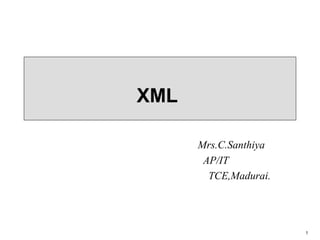Xml p3 -Lecture Notes
- 2. xsd âĒ Schema --- 1.Simple type(no child,attributes) âĒ restriction,built in data types. âĒ 2.Complex type(can contain) âĒ Simple content----no child,extension,restriction. âĒ Complex content------child,no limitations 2
- 4. Top Layer âĒ <?xml version="1.0"?> <note xmlns="https://www.w3schools.com" xmlns:xsi="http://www.w3.org/2001/XMLSchema- instance" xsi:schemaLocation="https://www.w3schools.com note.xsd"> <to>Tove</to> <from>Jani</from> <heading>Reminder</heading> <body>Don't forget me this weekend!</body> </note> 4
- 5. XSD-Schema âĒ Syntax <xs:schema xmlns:xs="http://www.w3.org/2001/XMLSchema"> <xs:element name="x" type="y"/> <xs:attribute name="x" type="y"/> Example Simple Type <xs:element name="age"> <xs:simpleType> <xs:restriction base="xs:integer"> <xs:minInclusive value="0"/> <xs:maxInclusive value="100"/> </xs:restriction> </xs:simpleType> </xs:element> 5
- 6. Restriction 6 <xs:element name="choice"> <xs:simpleType> <xs:restriction base="xs:string"> <xs:pattern value="[xyz]"/> </xs:restriction> </xs:simpleType> </xs:element>
- 7. âĒ <xs:element name="letter"> <xs:simpleType> <xs:restriction base="xs:string"> <xs:pattern value="([a-z])*"/> </xs:restriction> </xs:simpleType> </xs:element> 7
- 8. Complex type âĒ <product pid="1345"/> âĒ <employee> <firstname>John</firstname> <lastname>Smith</lastname> </employee> âĒ <food type="dessert">Ice cream</food> âĒ <description> It happened on <date lang="norwegian">03.03.99</date> .... </description> 8
- 22. Group Indicators âĒ <xs:group name="groupname"> ... </xs:group> âĒ <xs:group name="persongroup">   <xs:sequence>     <xs:element name="firstname" type="xs:string"/>     <xs:element name="lastname" type="xs:string"/>     <xs:element name="birthday" type="xs:date"/>   </xs:sequence> </xs:group> 22
- 31. Complex type âĒ <xml version=â1.0â> âĒ <schema xmlns=http://www.w3.org/2001/XMLSchema âĒ                 xmlns:computer= ââ âĒ                 targetnamespace=â â> âĒ <simpleType name=âgigahertzâ> âĒ  <restriction  base=âdecimalâ> âĒ <mininclusive value=â2.1â/> âĒ </restriction> âĒ </simpleType> âĒ <complexType name=âCPUâ> âĒ <simpleContent> âĒ <extension base=âstringâ> âĒ <attribute name=âmodelâ   type=âstringâ/> âĒ </extension> âĒ </simpleContent> âĒ </complexType> 31
- 32. Complex type âĒ <complexType name=âportableâ> âĒ <all> âĒ         <element name=âprocessorâ  type=âcomputer:cpuâ /> âĒ          <element name=âmonitorâ  type=âintâ /> âĒ <element name=âCPUSpeedâ  type=âcomputer:gigahertzâ /> âĒ <element name=âRAMâ  type=âintâ /> âĒ </all> âĒ <attribute name=âmanufacturerâ type=âstringâ /> âĒ </complexType> âĒ <element  name=âlaptopâ type=âcomputer:portableâ /> âĒ </schema> 32





![Restriction
6
<xs:element name="choice">
<xs:simpleType>
<xs:restriction base="xs:string">
<xs:pattern value="[xyz]"/>
</xs:restriction>
</xs:simpleType>
</xs:element>](https://image.slidesharecdn.com/xmlp3-180105203123/85/Xml-p3-Lecture-Notes-6-320.jpg)
![âĒ <xs:element name="letter">
<xs:simpleType>
<xs:restriction base="xs:string">
<xs:pattern value="([a-z])*"/>
</xs:restriction>
</xs:simpleType>
</xs:element>
7](https://image.slidesharecdn.com/xmlp3-180105203123/85/Xml-p3-Lecture-Notes-7-320.jpg)
























